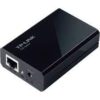TP-Link TL-POE150S Power Over Ethernet Injector
TP-Link TL-POE150S Power Over Ethernet Injector delivers both electrical power and network data through a single ethernet cable, eliminating the need for separate power adapters when installing PoE-compatible devices like IP cameras, wireless access points, and VoIP phones. This compact injector converts standard ethernet connections into PoE-enabled links, allowing users to power network devices in locations where electrical outlets are unavailable or impractical to access.
Unlike PoE switches that require replacing existing network infrastructure, this standalone injector works with any standard ethernet switch or router, adding PoE capability to specific network connections as needed. The device provides up to 15.4 watts of power per IEEE 802.3af standard while maintaining full gigabit ethernet data transmission, making it an economical solution for powering individual devices without upgrading entire network systems.
Power Over Ethernet Technology and Standards
IEEE 802.3af Compliance and Power Delivery
The TP-Link TL-POE150S Power Over Ethernet Injector adheres to industry-standard PoE specifications:
- Power output: Up to 15.4 watts delivered to connected PoE devices
- Voltage specification: 48V DC nominal output with automatic regulation
- Current capacity: Up to 350mA continuous current delivery
- Power efficiency: High-efficiency power conversion minimizes energy waste and heat generation
Safe Power Detection and Delivery
Advanced safety mechanisms protect both the injector and connected devices:
- Device detection: Automatically identifies PoE-compatible devices before applying power
- Signature verification: Ensures connected device can safely accept PoE power delivery
- Overload protection: Automatic shutdown prevents damage from excessive current draw
- Short circuit protection: Immediate power disconnection protects against wiring faults
Network Data Transmission and Connectivity
Gigabit Ethernet Performance Maintenance
Power injection occurs without compromising network data transmission quality:
- Full gigabit support: Maintains 1000 Mbps data speeds through the PoE connection
- Backward compatibility: Supports 100 Mbps and 10 Mbps ethernet standards
- Auto-negotiation: Automatically configures optimal speed and duplex settings
- Signal integrity: Power delivery uses unused wire pairs, preserving data signal quality
Port Configuration and Connection Layout
Simple two-port design facilitates straightforward installation:
- Data input port: Connects to standard ethernet switch or router port
- PoE output port: Delivers combined power and data to PoE device
- Pass-through design: Non-PoE devices receive standard ethernet connectivity when connected
- Plug-and-play operation: No configuration required for basic power delivery functionality
Practical Applications and Use Cases
IP Security Camera Installations
The TP-Link TL-POE150S Power Over Ethernet Injector addresses common surveillance system challenges:
- Remote camera locations: Powers IP cameras in areas without nearby electrical outlets
- Outdoor installations: Reduces weatherproofing requirements by eliminating separate power connections
- Cable management: Single ethernet cable provides both network connectivity and power supply
- Installation cost reduction: Eliminates need for electrical work and additional power cables
Wireless Access Point Deployment
Network expansion projects benefit from simplified power delivery:
- Ceiling-mounted access points: Powers Wi-Fi equipment in difficult-to-reach locations
- Warehouse and industrial: Provides power for access points in large commercial spaces
- Temporary installations: Quick deployment for events or temporary network extensions
- Retrofit installations: Adds PoE capability to existing ethernet infrastructure without rewiring
Installation Process and Setup Procedures
Physical Installation Steps
Setting up the TP-Link TL-POE150S Power Over Ethernet Injector requires minimal technical knowledge:
- Power connection: Connect included power adapter to injector and electrical outlet
- Network input: Connect ethernet cable from switch or router to injector’s “Data In” port
- Device connection: Connect ethernet cable from injector’s “PoE Out” port to powered device
- Verification: Confirm PoE device powers on and network connectivity functions properly
Cable Requirements and Specifications
Proper cabling ensures reliable power delivery and data transmission:
- Cable category: Category 5e or higher ethernet cables required for reliable PoE operation
- Distance limitations: Maximum 100 meters (328 feet) from injector to powered device
- Wire quality: Solid copper conductors recommended over copper-clad aluminum for power delivery
- Connection integrity: Properly terminated RJ45 connectors essential for power and data reliability
Compatible Devices and Power Requirements
Standard PoE Device Compatibility
The injector powers various network devices within its power specification:
- IP cameras: Most standard-definition and many HD IP cameras requiring up to 15 watts
- Wireless access points: Entry-level and mid-range Wi-Fi access points with PoE power requirements
- VoIP phones: Business IP phones and video phones with standard PoE power needs
- Network sensors: Environmental monitoring devices, door controllers, and IoT sensors
Power Budget Management
Understanding device power consumption helps ensure reliable operation:
- Power headroom: Connected devices should consume less than 12-13 watts for reliable operation
- Startup current: Some devices require higher power during initialization than steady-state operation
- Temperature derating: Power output may decrease in high-temperature environments
- Multiple device consideration: Each injector powers only one device; multiple devices require additional injectors
Installation Environments and Mounting Options
Physical Placement and Environmental Considerations
Proper installation location ensures reliable long-term operation:
- Temperature range: Operating temperature from 0°C to 40°C (32°F to 104°F)
- Humidity tolerance: 10% to 90% relative humidity, non-condensing
- Ventilation requirements: Adequate airflow prevents overheating during continuous operation
- Mounting options: Desktop placement or wall mounting using included hardware
Professional Installation Scenarios
Various environments benefit from PoE injector deployment:
- Office renovations: Adding PoE capability without rewiring existing ethernet infrastructure
- Retail installations: Powering point-of-sale systems and security cameras in commercial spaces
- Educational facilities: Classroom technology installations requiring flexible power solutions
- Healthcare environments: Medical device connectivity with simplified power requirements
Safety Features and Regulatory Compliance
Electrical Safety and Protection Systems
Comprehensive safety mechanisms protect equipment and installations:
- Overcurrent protection: Automatic shutdown prevents damage from excessive power draw
- Thermal protection: Temperature monitoring prevents overheating damage
- Surge protection: Built-in surge suppression protects against power line disturbances
- Ground fault protection: Safety systems detect and respond to electrical faults
Standards Compliance and Certifications
- IEEE 802.3af: Full compliance with PoE standard ensuring universal device compatibility
- FCC certification: Meets electromagnetic interference and safety requirements
- CE marking: European conformity certification for safety and environmental standards
- RoHS compliance: Lead-free construction meets environmental protection requirements
Performance Monitoring and Troubleshooting
Diagnostic Capabilities and Status Indication
LED indicators provide visual feedback on operational status:
- Power LED: Confirms injector receives electrical power and functions normally
- PoE LED: Indicates successful PoE device detection and power delivery
- Link LED: Shows network data connection status between injector and switch
- Activity indicators: Network traffic visualization confirms data transmission
Common Issues and Resolution Strategies
Typical problems and their solutions help maintain reliable operation:
- Device not powering: Verify PoE compatibility and cable connection integrity
- Intermittent operation: Check power adapter connection and cable quality
- Network connectivity loss: Confirm ethernet cable specifications and connection security
- Overheating issues: Improve ventilation and verify ambient temperature conditions
Limitations and Alternative Solutions
Technology Constraints and Boundaries
The TP-Link TL-POE150S Power Over Ethernet Injector operates within specific technical parameters:
- 15.4-watt power limit: Cannot power high-wattage devices requiring PoE+ (25.5W) or PoE++ (60-90W)
- Single device capacity: Each injector powers only one PoE device
- Distance limitations: 100-meter ethernet cable length restriction applies
- No data management: Provides power delivery only without advanced network management features
When to Consider Alternative Solutions
Different PoE solutions may provide superior functionality for specific requirements:
- PoE+ requirements: Devices needing more than 15 watts require PoE+ injectors or switches
- Multiple devices: PoE switches more economical for powering numerous devices simultaneously
- Managed networks: PoE switches with management capabilities provide better control and monitoring
- High-power applications: PoE++ solutions necessary for advanced cameras and access points
Cost Analysis and Investment Benefits
Economic Advantages Over Alternative Solutions
PoE injectors provide cost-effective power delivery compared to other options:
- Electrical work avoidance: Eliminates need for certified electricians and additional electrical circuits
- Cable consolidation: Single ethernet cable replaces separate power and data connections
- Installation flexibility: Easier device relocation without rewiring power connections
- Maintenance reduction: Fewer components and connections reduce potential failure points
Total Cost of Ownership Considerations
- Initial investment: Lower upfront cost compared to PoE switch replacement
- Energy efficiency: High-efficiency power conversion reduces ongoing electrical costs
- Scalability: Individual injectors allow gradual network expansion
- Future compatibility: Standard PoE compatibility ensures long-term device support
Professional Installation and Integration
Network Infrastructure Integration
The injector integrates seamlessly with existing network equipment:
- Switch compatibility: Works with any ethernet switch or router with available ports
- Network topology: Transparent operation maintains existing network architecture
- VLAN support: Passes VLAN tags and network management traffic without modification
- Security compliance: Maintains network security policies and access controls
Structured Cabling Considerations
Professional installations benefit from proper planning and implementation:
- Cable management: Organized routing of power and data cables for professional appearance
- Documentation: Proper labeling and documentation of PoE connections for maintenance
- Testing procedures: Cable testing and power verification ensure reliable operation
- Future expansion: Planning for additional PoE devices and power requirements
Support and Warranty Information
Technical Support Resources
TP-Link provides comprehensive support for PoE installation challenges:
- Installation guides: Detailed documentation for various deployment scenarios
- Compatibility lists: Device compatibility verification and power requirement databases
- Troubleshooting resources: Common issue resolution and diagnostic procedures
- Technical assistance: Professional support for complex installation and configuration issues
Warranty Coverage and Protection
- Standard warranty: Manufacturer warranty protects against defects and premature failure
- RMA process: Streamlined replacement procedures for defective units
- Quality assurance: Comprehensive testing ensures reliable long-term operation
- Customer support: Multiple contact methods for technical assistance and warranty claims




Reviews
There are no reviews yet.